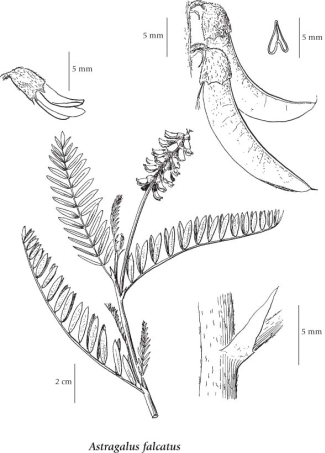Astragalus falcatus Lam.
Russian sickle milk-vetch (Russian milkvetch)
Fabaceae (Pea family)
Introduction to Vascular Plants
Russian sickle milk-vetch (Russian milkvetch)
Fabaceae (Pea family)
Introduction to Vascular Plants
Species Information
General:
Stout perennial herb from a stem-base; stems erect to ascending, 40-80 cm tall, thinly short-appressed-hairy with black and white, basally 2-forked hairs.
Leaves:
Alternate, pinnately compound, nearly unstalked, 7-15 cm long; leaflets 19 to 37, oblong to elliptic, pointed at the tip, 10-30 mm long; stipules lanceolate, membranous, 5-12 mm long, the lowermost fused into a sheath, the upper ones free.
Flowers:
Inflorescence a spike-like, axillary raceme of 10 to 50 drooping, pea-like flowers, the racemes 6-20 cm long on stout stalks 6-15 cm long; corollas yellowish- or greenish-white, sometimes purplish-tinged, 7-10 mm long, the banner stubby, about as long as the wings and keel; calyces about 5 mm long, the triangular or awl-shaped teeth 1/3-1/2 as long as the bell-shaped tube.
Fruits:
Pods, lanceolate or lance-elliptic, sickle-shaped, 2-3 cm long, unstalked, drooping, stiff-papery or somewhat leathery, glabrous to thinly appressed-hairy, 2-chambered.
Illustration

If more than one illustration is available for a species (e.g., separate illustrations were provided for two subspecies) then links to the separate images will be provided below. Note that individual subspecies or varietal illustrations are not always available.
Illustration Source: The Illustrated Flora of British Columbia